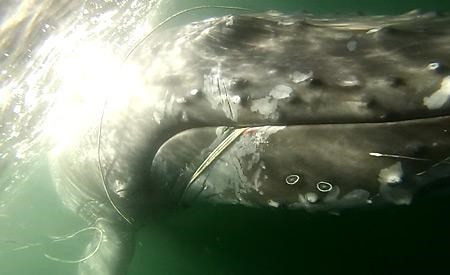A juvenile humpback whale is swimming free after fisheries officers disentangled it from prawning traps off Harwood Island.
Department of Fisheries and Oceans (DFO) received a call from boaters, Allison Wilson and Cliff Klapstein, who were in the area and discovered the tangled whale Sunday evening, June 21.
Fisheries officers Matt Conley, Ben Rahier and Paul Cottrell, a marine mammal disentanglement specialist, found the whale, which had become caught up in about 50 prawn traps and gear, weighing close to 500 kilograms and anchored to the sea floor. Cottrell is the DFO’s marine mammal coordinator.
“It was a terrible entanglement and it would have been certainly lethal,” he said to the Peak. “It’s really an expert team that has to do this. It is really dangerous.”
Cottrell, who works out of DFO’s regional headquarters in Vancouver, has many years’ experience disentangling whales but rarely has had cases in the Strait of Georgia, he said. “It’s never happened here before. I do disentanglements all over the coast and inside Georgia Strait we’ve had animals entangled but we’ve never been able to get out and successfully grapple on and deal with them.”
Once DFO was notified, Cottrell contacted Conley, DFO field supervisor in Powell River, to start the team’s planning. They were assisted by a Canadian Coast Guard vessel in the rescue.
Cottrell estimated that the whale had spent close to 24 hours caught up in the prawning gear. “It was caught in a cluster of ropes,” he added. “We put a plan together. There was a mass of ropes wrapped around the whale and some through its mouth.”
The team used waterproof GoPro cameras to examine where the bulk of the lines were and then proceeded to free the animal making systematic cuts to ropes. Cottrell said part of the danger of freeing a whale this way is that it is necessary to make sure all the lines and gear is removed before the whale becomes free and swims away.
The team worked from the head to the tail of the animal, starting with the ropes in the animal’s mouth. Most of the tension was on the whale’s tail. “It was basically hogtied to the bottom,” he said.
“Because it was anchored and just the sheer weight it had to lift each time to breath, I’m sure it would have eventually died if we weren’t there to free it,” he said.
Officers spent close to four hours removing the ropes, before the young whale, measuring close to 35 feet, was freed.
“Going through something like this you have to be so careful,” Cottrell added. “You’re always worried that you’re not going to make the right cut. But we did.”
Once free, the whale started cruising off at five or six knots, he said, but stayed on the surface for nearly a nautical mile before diving, which reassured the officers that it was clear of the ropes and gear.
The boat followed the whale for officers to take pictures to help identify and catalogue the animal, he said.
Cottrell said the whale sustained a fair amount of injury from the tangled ropes, but none of its injuries are now life-threatening. He emphasized the need for the public to contact fisheries if an entangled whale is encountered. Last year, he added, three whales died after well meaning people cut lines to free entangled whales but did not ensure that all the gear was removed.
The public can report sick, injured, distressed or deceased marine mammals to the BC Marine Mammal Incident hotline at 1.800.465.4336.



